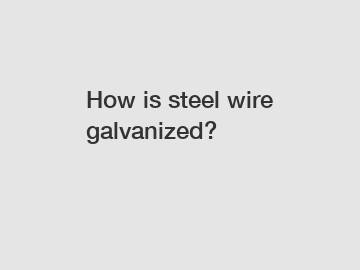How is steel wire galvanized?
Steel wire galvanization is a process that involves applying a protective zinc coating to the surface of the wire to prevent rust and corrosion. This process is commonly used in various industries, including construction, automotive, and manufacturing, to increase the lifespan and durability of steel wire products.
Galvanization is a time-tested and proven method of protecting steel wire from environmental factors that can cause deterioration. The process starts with cleaning the steel wire to remove any dirt, grease, or contaminants that could interfere with the bonding of the zinc coating. This is typically done through a chemical or mechanical cleaning process to ensure that the surface of the wire is free from impurities.
Once the steel wire is clean, it is then immersed in a bath of molten zinc at a temperature of around 860°F (460°C). The high temperature of the zinc bath allows the molten zinc to bond with the steel wire through a process called metallurgical bonding. This results in a strong and durable coating that is resistant to rust and corrosion.

After the steel wire is immersed in the zinc bath, it is removed and allowed to cool. The zinc coating solidifies on the surface of the wire, forming a protective barrier that shields the steel from moisture, oxygen, and other corrosive elements. This coating not only prevents rust and corrosion but also provides a smooth and uniform finish that enhances the appearance of the steel wire.
There are two main methods of galvanizing steel wire: hot-dip galvanizing and electro-galvanizing. Hot-dip galvanizing is the more traditional method and involves immersing the steel wire in a bath of molten zinc. This process is typically used for larger steel wire products or when a thicker zinc coating is required. Electro-galvanizing, on the other hand, involves using an electric current to deposit a thin layer of zinc onto the surface of the steel wire. This method is often used for smaller wire products or when a more precise coating thickness is needed.
In addition to protecting steel wire from rust and corrosion, galvanization also provides other benefits. The zinc coating acts as a sacrificial anode, meaning that it will corrode before the steel wire does. This sacrificial protection prolongs the life of the steel wire and reduces maintenance costs over time. Galvanized steel wire is also more resistant to abrasion, making it ideal for applications where the wire may be subject to wear and tear.
Overall, the process of galvanizing steel wire is a highly effective and efficient way to protect steel products from rust and corrosion. By applying a zinc coating to the surface of the wire, manufacturers can increase the longevity and durability of their products, leading to cost savings and improved performance in a wide range of applications. Whether used in construction, automotive, or manufacturing, galvanized steel wire offers a reliable and long-lasting solution for protecting steel products in challenging environments.
In conclusion, galvanizing steel wire is a time-tested and proven method of protecting steel products from rust and corrosion. By applying a zinc coating to the surface of the wire, manufacturers can increase the lifespan and durability of their products, leading to cost savings and improved performance. Whether using hot-dip galvanizing or electro-galvanizing, the process of galvanizing steel wire offers a reliable and long-lasting solution for protecting steel products in a wide range of applications.
Want more information on customized wire ropes for controlling, high strength steel wire rope for lifting, customized galvanized wire ropes? Feel free to contact us.

Comments
0